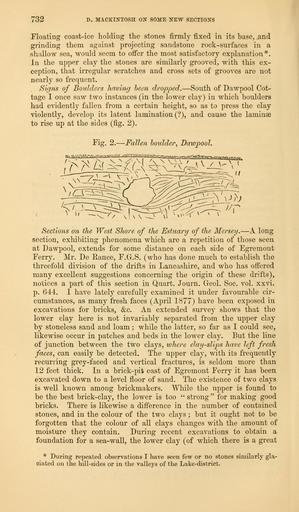MAKE A MEME
View Large Image

| View Original: | The_Quarterly_journal_of_the_Geological_Society_of_London_(12736589543).jpg (1866x3200) | |||
| Download: | Original | Medium | Small | Thumb |
| Courtesy of: | commons.wikimedia.org | More Like This | ||
| Keywords: The Quarterly journal of the Geological Society of London (12736589543).jpg 732 <br> D MACKINTOSH ON SOME NEW SECTIONS <br> Floating coast-ice holding the stones firmly fixed in its base and <br> grinding them against projecting sandstone rock-surfaces in a <br> shallow sea would seem to offer the most satisfactory explanation <br> In the upper clay the stones are similarly grooved with this ex- <br> ception that irregular scratches and cross sets of grooves are not <br> nearly so frequent <br> Signs of Boulders having been dropped ” South of Dawpool Cot- <br> tage 1 once saw two instances in the lower clay in which boulders <br> had evidently fallen from a certain height so as to press the clay <br> violently develop its latent lamination and cause the laminae <br> to rise up at the sides fig 2 <br> Pig 2 ” Fallen boulder Dawpool <br> Sections on the West Shore of the Estuary of the Mersey ” A long <br> section exhibiting phenomena which are a repetition of those seen <br> at Dawpool extends for some distance on each side of Egremont <br> Ferry Mr De Ranee F G S who has done much to establish the <br> threefold division of the drifts in Lancashire and who has offered <br> many excellent suggestions concerning the origin of these drifts <br> notices a part of this section in Quart Journ Geol Soc vol xxvi <br> p 644 I have lately carefully examined it under favourable cir- <br> cumstances as many fresh faces April 1877 have been exposed in <br> excavations for bricks c An extended survey shows that the <br> lower clay here is not invariably separated from the upper clay <br> by stoneless sand and loam ; while the latter so far as I could see <br> likewise occur in patches and beds in the lower clay But the line <br> of junction between the two clays where clay-slips have left fresh <br> faces can easily be detected The upper clay with its frequently <br> recurring grey-faced and vertical fractures is seldom more than <br> 12 feet thick In a brick-pit east of Egremont Ferry it has been <br> excavated down to a level floor of sand The existence of two clays <br> is well known among brickmakers While the upper is found to <br> be the best brick-clay the lower is too strong for making good <br> bricks There is likewise a difference in the number of contained <br> stones and in the colour of the two clays ; but it ought not to be <br> forgotten that the colour of all clays changes with the amount of <br> moisture they contain During recent excavations to obtain a <br> foundation for a sea-wall the lower clay of which there is a great <br> During repeated observations I have seen few or no stones similarly gla- <br> ciated on the hill-sides or in the valleys of the Lake-district 35818909 110705 51125 Page 732 Text 33 http //www biodiversitylibrary org/page/35818909 1877 Geological Society of London Biodiversity Heritage Library The Quarterly journal of the Geological Society of London v 33 1877 Geology Periodicals Smithsonian Libraries bhl page 35818909 dc identifier http //biodiversitylibrary org/page/35818909 smithsonian libraries Information field Flickr posted date ISOdate 2014-02-24 Check categories 2015 August 26 CC-BY-2 0 BioDivLibrary https //flickr com/photos/61021753 N02/12736589543 2015-08-26 20 04 36 cc-by-2 0 PD-old-70-1923 The Quarterly journal of the Geological Society of London 1877 Photos uploaded from Flickr by Fæ using a script | ||||